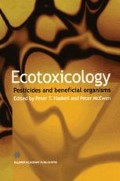Abstract
One of the paradigms of ecotoxicology is the practical need to select a limited number of species for evaluating the environmental effects of chemicals, whilst wishing to apply or extrapolate the findings to other (related) species or groups of organisms which are at risk of exposure within the same environmental compartment. This is true for those working with organisms inhabiting the marine, freshwater, soil and crop environments.
Access this chapter
Tax calculation will be finalised at checkout
Purchases are for personal use only
Preview
Unable to display preview. Download preview PDF.
References
Aebischer, N.J. (1992) Twenty years of monitoring invertebrates and weeds in cereal fields in Sussex, in The Ecology of Temperate Cereal Fields, (eds L.G. Firbank, N. Carter, J.F. Derbyshire and G.R. Potts), Blackwell Scientific Publications, Oxford, pp. 305–331.
Aldridge, C. and Carter, N. (1992) The principles of risk assessment for non-target arthropods: a UK perspective, in Interpretation of Pesticide Effects on Beneficial Arthropods, (eds R.A. Brown, P.C. Jepson and N.W. Sotherton), Aspects of Applied Biology 31, 149–156.
Baird, D.J., Maltby, L., Greig-Smith, P.W. and Douben, P.E.T. (1996) Ecototoxicology: Ecological Dimensions,Ecotoxicology Series 4,Chapman & Hall, London, 89 pp.
Barrett, K.L., Grandy, N., Harrison, E.G. et al. (1994) Guidance Document on Regulatory Testing Procedures for Pesticides with Non Target Arthropods. From the ESCORT workshop, Wageningen, Netherlands, March 1994, SETAC-Europe, Brussels.
Beard, R.C.W. and Mauremootoo, J.R. (1994) The biodiversity of Coleoptera in arable field boundaries, in Proceedings of the BCPC Conference — Pests and Diseases, Vol. 3, pp. 943–950.
Calow, P., Sibley, R.M. and Forbes, V. (1997) Risk assessment on the basis of simplified life-history scenarios. Environmental Toxicology and Chemistry, 16, 1983–1989.
Chowdhury, A.B.M.N.U. (1996) Studies on the effects of different leaf characteristics on the mediation of toxicity of exposed organisms. Unpublished M.Phil. transfer report, University of Southampton, UK, 169 pp.
Croft, B.A. (1990) Arthropod Biological Control Agents and Pesticides, John Wiley and Sons, New York, 723 pp.
De Snoo, G.R., Canters, K.J., De Jong, F.M.W. and Cupreus, R. (1994) Integral hazard assessment of side effects of pesticides in The Netherlands — a proposal. Environmental Toxicology and Chemistry, 13, 1331–1340.
EPPO (1994) Decision-making schemes for the environmental risk assessment of plant protection products — arthropod natural enemies, Bulletin OEPP/EPPO 24(1), 17–35.
Greig-Smith, P.W. (1992a) The acceptability of pesticide side-effects on non-target arthropods, in Interpretation of Pesticide Effects on Beneficial Arthropods, (eds R.A. Brown, P.C. Jepson and N.W. Sotherton), Aspects of Applied Biology 31, 121–132.
Greig-Smith, P.W. (1992b) A European perspective to ecological risk assessment, illustrated by pesticide registration procedures in the United Kingdom. Environmental Toxicology and Chemistry, 111673–1689.
Hoekstra, J.A., Vaal, M.A. and Notenboom, J. (1992) Sensitivity Patterns of Aquatic Species to Toxicants: a Pilot Study, RIVM Report No. 719102016, Bilthoven, The Netherlands.
Jepson, P.C. (1989) The temporal and spatial dynamics of pesticide side-effects on non-target invertebrates, in Pesticides and Non-target Invertebrates, (ed. P.C. Jepson), Intercept, Wimborne, Dorset, pp. 95–127.
Jepson, P.C. (1993) Ecological insights into risk analysis: the side-effects of pesticides as a case study. The Science of the Total Environment, Supplement 1993, 1547–1566.
Kjaer, C. and Jepson, P.C. (1995) The toxic effects of direct pesticide exposure for a non-target weed-dwelling chrysomelid beetle (Gastrophysa polygoni) in cereals. Environmental Toxicology and Chemistry, 14, 993–999.
Longley, M. (1995) The effects of pesticides on butterflies inhabiting farmland. Unpublished Game Conservancy Report, Fordingbridge, Hants.
Longley, M. and Sotherton, N.W. (1997) Factors determining the effects of pesticides upon butterflies inhabiting farmland. Agriculture, Ecosystems and Environment, 61, 1–12.
Potts, G.R. (1991) The environmental and ecological importance of cereal fields, in The Ecology of Temperate Cereal Fields, (eds L.G. Firbank, N. Carter J.F. Darbyshire and G. R. Potts), Blackwell, Oxford, pp. 3–21.
Sotherton, N.W. (1990) The effects of six insecticides used in UK cereal fields on sawfly larvae (Hymenoptera: Tenthredinidae), in Proceedings of the Brighton Crop Protection Conference — Pests and Diseases 1990, pp. 999–1004.
Vickerman, G.P. (1992) The effects of different pesticide regimes on the invertebrate fauna of winter wheat, in Pesticides and the Environment: the Boxworth Study, (eds P.W. Greig-Smith, G.K. Frampton and A.R. Hardy), HMSO, London, pp. 82–109.
Wiles, J.A. and Frampton, G.K. (1996) A field bioassay approach to assess the toxicity of insecticide residues on soil to Collembola. Pesticide Science, 47, 273–285.
Wiles, J.A. and P.C. Jepson (1992) The susceptibility of a cereal aphid pest and its natural enemies to deltamethrin. Pesticide Science, 36, 263–272.
Wiles, J.A. and P.C. Jepson (1994) Substrate-mediated toxicity of deltamethrin residues to beneficial invertebrates: estimation of toxicity factors to aid risk assessment. Archives of Environmental Contamination and Toxicology, 27, 384–391.
Editor information
Editors and Affiliations
Rights and permissions
Copyright information
© 1998 Springer Science+Business Media Dordrecht
About this chapter
Cite this chapter
Wiles, J.A., Barrett, K.L. (1998). Approaches for extrapolating pesticide side-effects between arthropod species: how much do we know?. In: Haskell, P.T., McEwen, P. (eds) Ecotoxicology. Springer, Boston, MA. https://doi.org/10.1007/978-1-4615-5791-3_35
Download citation
DOI: https://doi.org/10.1007/978-1-4615-5791-3_35
Publisher Name: Springer, Boston, MA
Print ISBN: 978-1-4613-7653-8
Online ISBN: 978-1-4615-5791-3
eBook Packages: Springer Book Archive

